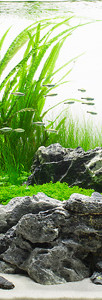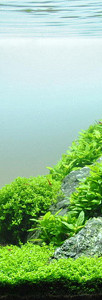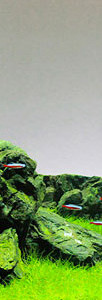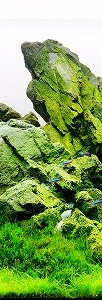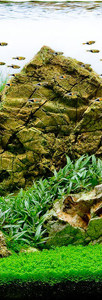Iwagumi Aquascaping style is defined by its bold stone formations, elegant simplicity, and commitment to creating a natural setting.
Utilizing stones as the primary aesthetic of the design and limited plants, Iwagumi Aquascaping style is considered to be one of the more difficult aquascaping styles.
The Iwagumi aquascaping style is a subset of Japanese Nature aquascaping that requires a significant amount of experience to implement and maintain.
The Iwagumi style follows a general layout that requires a balance between open space, hardscape, and scale between each aspect of the design.
Table of Contents
Iwagumi Aquascape
Iwagumi aquascaping is a kind of landscaping that involves arranging stones in a structured format inside an aquarium. You must create symmetry and balance by using an odd number of stones. Each stone plays a specific role in the aquascape.
Main Components of Iwagumi Aquascaping Style
“Iwagumi” in Japanese translates to “Rock Formation,” which in turn refers to the stone architecture, formations, and placement defining the features of the design.
Essentially, the stones in an Iwagumi aquascape act as the structure of the entire design.
Traditionally, there are three stones in an Iwagumi aquascape; however, the aquascaper has the liberty to build his or her design based upon preference.
Odd number is the key
In the Iwagumi style, the main requirement is to use an odd number of stones, as this prevents portraying the aquascape as unnatural.
Creating symmetry and balance in a natural setting is uncommon and is typically evidence of human involvement.
Utilizing an odd number of stones prevents the human eye from splitting the design down the middle and creating unnatural symmetry.
Apart from stone architecture, Iwagumi style also utilizes fish and plants, but to a minimum degree as the aquascaper should be striving to balance all aspects of the design to reflect simple tranquility.
Basic Design and Layout
In the Iwagumi style, each stone in the layout has a specific name and role to play in the overall aquascape.
While aquascapers can use as many odd-numbered sequences of stones, the role of each stone should be similar to the following:
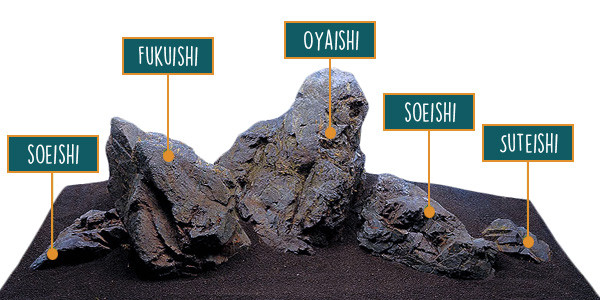
Oyaishi
Typically the largest or most aesthetic of the entire design, Oyaishi is always used as the centerpiece of your Iwagumi aquascape.
As the main focal point of the aquarium, the Oyaishi is often angled with the flow of water to mimic a natural river stone.
Fukuishi
As in Futatsu (二つ) or 2, the Fukuishi is the second largest stone in your aquascape and should be similar to Oyaishi in regards to color, gradient, and tone.
Traditionally, it is placed to the left or right of Oyaishi. Fukuishi should serve as a balancing piece to the Oyaishi.
Soeishi
The third-largest stone, its primary purpose is to accentuate the beauty of the primary stone counterparts.
Suteishi
Plantlife or other flora often covers the smallest stone in the aquascape, Suteishi, also known as “the sacrificial stone.”
Although Suteishi never stands alone as a primary focal piece of the aquarium, it still plays a key role in balancing the rest of the design.
Recommended Plants and Fish
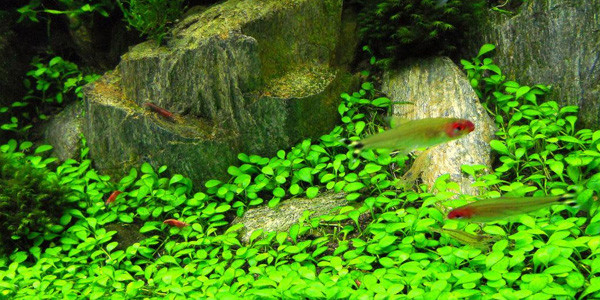
Plants in the Iwagumi style are limited to maintain the balance of simplicity with the rock formations. However, it is common for aquascapers to use the benefits of carpet flora and open space.
Glossostigma elatinoides, Dwarf hairgrass (Eleocharis acicularis), and Hemianthus callitrichoides are among the most popular selections.
Fish should also embody a theme of minimalism and harmony with the rest of your design. The addition of fish to your aquascape should bring about tranquility and life to your aquarium.
Schooling fish species like Harlequin rasboras, Rummy nose tetras, and Cardinal tetras are most commonly used in this style. Avoid using individualistic shoaling fish that create an imbalance in the aquascape.
Challenges of Iwagumi Aquascaping Style
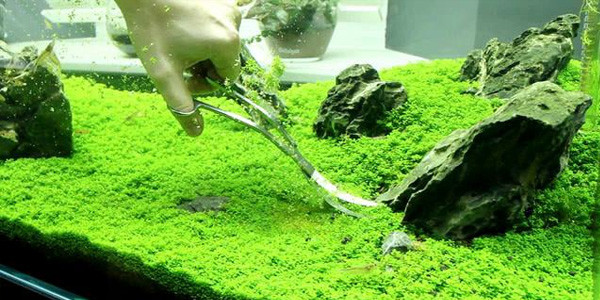
Iwagumi style may look easier to complete than other more popular styles, however, it is quite difficult to maintain.
For example, the limited choice of plants makes it arduous to have a sustainable growth process.
Plants used in Iwagumi are typically heavy root feeders, making the system between the substrate and water filtration a difficult choice for the aquascaper.
In addition, the aquascape is prone to algae formation at any time during the cultivation of your project.
Sanzon Iwagumi
Sanzon Iwagumi is one of the different forms of Iwagumi, crafted intricately with stones. There are three stones in Sanzon IwagumiIwaguni, out of which one stone is greater than the other two. Three stones are compared to the Buddhist triple, thus the name Sanzon Iwagumi. Chusonseki is the name of the central stone, while Kiujiseki is the name of the other two side stones.
Laying Out A Traditional Iwagumi
Lay an equal substrate layer on the aquarium’s floor for a classic Iwagumi. More substrate will be added along with stones.
Add the Oyaishi (primary and largest stone). According to the Golden Ratio Rule, the stone should be around 2/3 the height and should be placed at a focal point that could be around 2/3 the width of the aquarium to give a natural look like river stones can tilt it in the direction in which water flows.
After that, arrange the other secondary stone (Fukuseki). This stone is placed in the right or left direction of the Oyaishi. It is generally used to balance (Oyaishi) primary stone. Fukuseki texture and color are similar to Oyaishi stone.
Now you need to assist the third stone named Soeishi, generally put next to the Oyaishi, along with the Fukuishi, to highlight the first one’s (Oyaishi) power.
The last stone (Suteishi) needs to be placed in the aquarium. Suteishi’s job is to complement the overall structure of the rock by assisting all of the other stones in creating a sense of unity.
Is There A Required Tank Dimension For An Iwagumi Layout?
If you wish to create a layout of Iwagumi and have a doubt regarding tank dimensions, let me tell you that you don’t have to be worried. These stones can be arranged in both smaller and large tanks. The only difference is that it would be easier to arrange the stones in long and large-sized tanks than small aquarium tanks. Designed with utmost dedication and craftsmanship, Iwagumi design is one of its kind!
Conclusion
The Iwagumi style is largely regarded as one of the most popular aquascaping styles and embodies elegance and beauty in the aquascaping art form.
Although the design may take some time to complete, the result will bring satisfaction for the work put forth.
In addition, the minimal design provides a low barrier to access in terms of getting started; as a result, an aquascaper may be able to get started with Iwagumi much quicker than the other styles that require more resources.
Iwagumi style is also definitive and diverse than other popular styles and allows the aquascaper to try a new style when compared to Jungle or Dutch styles.
Embodying the Japanese principles of simplicity and spirituality, the Iwagumi style is a hard-earned, but rewarding, aquascape.

